Punjab State Board PSEB 10th Class Maths Book Solutions Chapter 13 Surface Areas and Volumes Ex 13.3 Textbook Exercise Questions and Answers.
PSEB Solutions for Class 10 Maths Chapter 13 Surface Areas and Volumes Ex 13.3
Question 1.
A metallic sphere of radius 4.2 cm is melted and recast into the shape of cylinder of radius 6 cm. Find the height of the cylinder.
Solution:
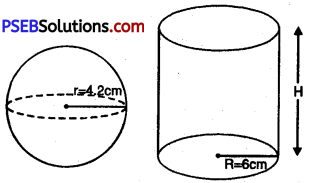
Radius of sphere (r) = 4.2 cm
Radius of cylinder (R) = 6 cm
Let height of cylinder be H cm
On recasting volume remain same
Volume of sphere = Volume of cylinder
\(\frac{4}{3}\) πR3 = πR2H
\(\frac{4}{3}\) × \(\frac{22}{7}\) × 4.2 × 4.2 × 4.2 = \(\frac{22}{7}\) × 6 × 6 × H
∴ H = \(\frac{\frac{4}{3} \times \frac{22}{7} \times 4.2 \times 4.2 \times 4.2}{\frac{22}{7} \times 6 \times 6}\)
= \(\frac{4}{3} \times \frac{42}{10} \times \frac{42}{10} \times \frac{42}{10} \times \frac{1}{6 \times 6}\)
= \(\frac{2744}{1000}\) = 2.744 cm
Hence, Height of cylinder (H) = 2.744 cm.
![]()
Question 2.
Metallic spheres of radii 6 cm, 8 cm and 10 cm, respectively, are melted to form a single solid sphere. Find the radius of the resulting sphere.
Solution:
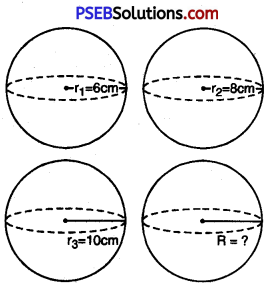
Radius of first sphere (r1) = 6 cm
Radius of second sphere (r2) = 8 cm
Radius of third sphere (r3) = 10 cm
Let radius of new sphere formed be R cm
On recasting volume remain same
Volume of all three spheres = Volume of big sphere
\(\frac{4}{3}\) πr13 + \(\frac{4}{3}\) πr23 + \(\frac{4}{3}\) πr33 = \(\frac{4}{3}\) πR3
\(\frac{4}{3}\) π[(6)3 + (8)3 + (10)3] = \(\frac{4}{3}\) πR3
R3 = \(\frac{\frac{4}{3} \pi[216+512+1000]}{\frac{4}{3} \pi}\)
R3 = 1728
R = \(\sqrt[3]{1728}\) = \(\sqrt[3]{2 \times 2 \times 2 \times 2 \times 2 \times 2 \times 3 \times 3 \times 3}\)
= 2 × 2 × 3
R= 12 cm
Hence, Radius of sphere = 12 cm.
![]()
Question 3.
A 20 m deep well with-diameter 7 m is dug and the earth from digging is evenly spread out to form of platform 22 m by 14 m. Find the height of the platform.
Solution:
Diameter of well = 7 m
Radius of well (cylinder) R = \(\frac{7}{2}\) m
Height of well (H) = 20 m
Length of Platform (L) =22 m
Width of Platform (B) = 14 m
Let height of Platform be H m
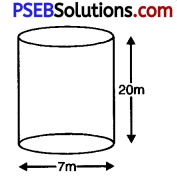
Volume of earth dug out from well = Volume of platform formed
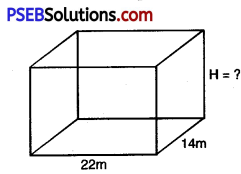
πR2H = L × B × H
× × × 20 = 22 × 14 × H
∴ H = \(\frac{\frac{22}{7} \times \frac{7}{2} \times \frac{7}{2} \times 20}{22 \times 14}\)
H = 2.5 cm
Hence, Height of Platform H = 2.5 cm.
![]()
Question 4.
A well of diameter 3 m is dug 14 m deep. The earth taken out of ¡t has been spread evenly all around it in the shape of a circular ring of width 4 m to form an embankment. Find the height of the embankment.
Solution:
Depth of well (h) = 14 m
Radius of well (r) = \(\frac{3}{2}\) m
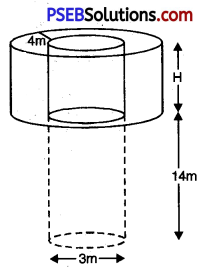
Embankment is in the shape of hollow cylinder whose inner radius is same as radius of well and width of embañkment 4 m
Timer radius of embankment = Radius of well(r) = \(\frac{3}{2}\) m
Outer radius of embankment (R) = (\(\frac{3}{2}\) + 4) m
R = \(\frac{11}{2}\) = 5.5 m
Volume of earth dug out = Volume of embankment (so formed)
πR2h = volume of outer cylinder – volume of inner cylinder
πr2h = πR2H – πr2H
= πH[R2 – r2]
\(\frac{22}{7} \times \frac{3}{2} \times \frac{3}{2} \times 14\) = \(\frac{22}{7}\) × H[(5.5)2 – (1.5)2]
H = \(\frac{\frac{22}{7} \times \frac{3}{2} \times \frac{3}{2} \times 14}{\frac{22}{7} \times(5.5-1.5)(5.5+1.5)}\)
= \(\frac{1.5 \times 1.5 \times 14}{4 \times 7}\) = 1.125 m.
Hence, Height of embankment H = 1.125 m.
![]()
Question 5.
A container shaped like a right circular cylinder having 4iameter 12 cm and height 15 cm Is full of ice-cream. The ice cream is to be filled into cones of height 12 cm and diameter 6 cm, having a hemispherical shape on the top. Find the number of such cones which can be tilled with ice-cream.
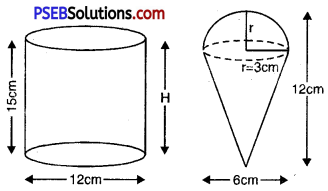
Dinieter of cvlrnder (D) = 12 cm
.. Radius of cylinder (R) = 6 cm
Height of cylinder (H) = 15 cm
Diameter of cone = 6 cm
Radius of cone (r) = 3 cm
Radius of hemisphere (r) = 3 cm
Height of cone (h) = 12 cm
Let us suppose number of cones used to fill the ice-cream = n
Volume of ice cream in container = n [Volume of ice cream in one cone]
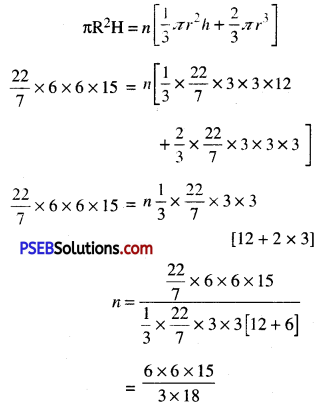
n = 10
Hence, Number of cones formed = 10.
![]()
Question 6.
How many silver coins 1.75 cm in diameter and of thickness 2 mm, must be melted to form a cuboid of dimensions
5.5 cm × 10 cm × 3.5 cm.
Solution:
Silver coin is in the form of cylinder
Diameter of silver coin = 1.75 cm
∴ Radius of silver coin (r) = \(\frac{1.75}{2}\) cm
Thickness of silver coin = Height of cylinder (H) = 2 mm
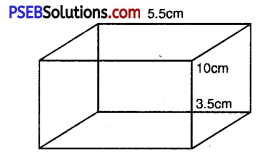
i.e., h = \(\frac{2}{10}\) cm.
Length of cuboid (L) = 5.5 cm
Width of cuboid (B) = 10 cm
Height of cuboid (H) = 3.5 cm
Let number of coins melted to form cuboid = n
∴ Volume of cuboid = n [volume of one silver coin]
= n[πr2h]
5.5 × 10 × 3.5 = n × \(\frac{22}{7} \times \frac{1.75}{2} \times \frac{1.75}{2} \times \frac{2}{10}\)
\(\frac{\frac{55}{10} \times 10 \times \frac{35}{10}}{\frac{22}{7} \times \frac{175}{200} \times \frac{175}{200} \times \frac{2}{10}}\) = n
n = 400
Hence, Number of corns so formed = 400.
![]()
Question 7.
A cylindrical bucket, 32 cm high and with radius of base 18 cm, is filled with sand. This bucket is emptied on the ground and a conical heap of sand is formed. If the height of the conical heap is 24 cm, find the radius and slant height of the heap.
Solution:
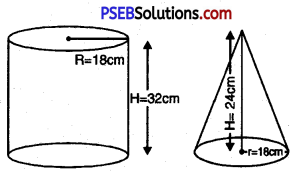
Radius of cylindrical bucket (R) = 18 cm
Height of cylindrical bucket (H) = 32 cm
Height of conical heap (h) = 24 cm
Let ‘r’ cm and ‘l’ cm be the radius and slant height of cone
Volume of sand in bucket = Volume of sand in cone
πR2H = \(\frac{1}{3}\) πr2h
\(\frac{22}{7}\) × 18 × 18 × 32 = \(\frac{1}{3}\) × \(\frac{22}{7}\) × r2 × 24
\(\frac{\frac{22}{7} \times 18 \times 18 \times 32}{\frac{1}{3} \times \frac{22}{7} \times 24}\) = r2
r2 = \(\frac{18 \times 18 \times 32}{8}\)
r2 = 1296
r = \(\sqrt{1296}\)
r = 36
∴ Radius of cone (r) = 36 cm
As we know,
(Slant height)2 = (Radius)2 + (Height)2
l = r2 + h2
l = \(\sqrt{(36)^{2}+(24)^{2}}\)
= \(\sqrt{1296+576}\) = \(\sqrt{1872}\)
= \(\sqrt{12 \times 12 \times 13}\)
l = 12\(\sqrt{13}\) cm
∴ Slant height of cone (1) = 12\(\sqrt{13}\) cm.
![]()
Question 8.
Water in a canal 6m wide and 1.5m deep is flowing with a speed of 10 km/k How much area will it irrigate in 30 minutes, If 8 cm of standing water is needed?
Solution:
Width of canal = 6 m
Depth of water in canal = 1.5 m
Velocity at which water is flowing = 10km/hr
Volume of water discharge in one hour = (Area of cross section) velocity
= (6 × 1.5m2) × 10 km
= 6 × 1.5 × 10 × 6 × 1.5 × 10 × 1000 × 1000 m3
∴ Volume of water discharge in \(\frac{1}{2}\) hour = \(\frac{1}{2}\) × \(\frac{6 \times 15}{10}\) × 1000 = 45000 m3
Let us suppose area to be irrigate = (x) m2
According to question, 8 cm standing water is required in field
∴ Volume of water discharge by canal in \(\frac{1}{2}\) hours = Volume of water in field 45000 m3 = (Area of field) × Height of water
45000 m3 = x × (\(\frac{8}{100}\) m)
\(\frac{4500}{8}\) × 100 = x
x = 562500 m2
x = \(\frac{562500}{10000}\) hectares
[1 m2 = \(\frac{1}{10000}\) hectares]
x = 56.25 hectares
Hence, Area of field = 56.25 hectares.
![]()
Question 9.
A farmer connects a pipe of Internal diameter 20 cm from a canal into a cylindrical tank in her field, which is 10 m in diameter and 2 m deep. If water flows through the pipe at the rate 0f 3km/h, in how much time will the tank be filled?
Solution:
Velocity of water = 3 km/hr
Diameter of pipe = 20 cm
Radius of pipe (r) = 10 cm = \(\frac{10}{100}\) m = \(\frac{1}{10}\) m
Diameter of tank = 10 m
Radius of tank (R) = 5 m
Depth of tank (H) = 2 m
Let us suppose pipe filled a tank in n minutes
Volume of water tank = Volume of water through the pipe in n minutes
πR2H = n[Area of cross section × Velocity of water]
πR2H = n[(πr2) × 3 km/h]
\(\frac{22}{7}\) × (5)2 × 2 = n[latex]\frac{22}{7} \times \frac{1}{10} \times \frac{1}{10} \times \frac{3 \times 1000}{60}[/latex]
25 × 2 × \(\frac{22}{7}\) = \(\frac{11}{7}\) n
n = \(\frac{25 \times 2 \times 22 \times 7}{11 \times 7}\)
n = 100 minutes
Hence, Time taken to fill the tank = 100 minutes.
